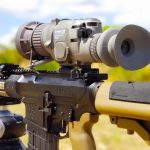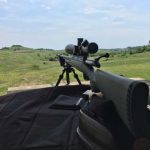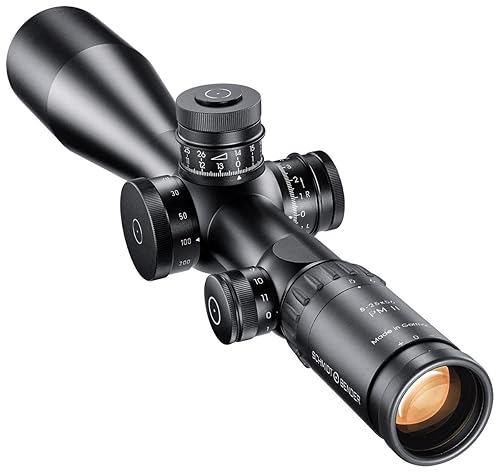If you know how a camera works and its similarities with your eye, there is a huge probability that you would know that how much you can see is solely dependent on the light conditions. Before you can see something, the light an object transmits must hit your retina. This will, in turn, be converted into electrical signals so you can see the thing in your view. It’s difficult to see in the dark and it has always been a restriction. Various experienced experts have built multiple types of equipment to enable visibility in the dark.

The thermal scope is one such technology. Thermal technology has significantly helped people to overcome this restriction. Unlike cameras, thermal technology does not use light to create an image, but heat radiation. Because of this innovative solution, people can now see objects in the dark without any issues. In this article, you will know what a thermal scope is, how it works, its advantages, and how to choose the best one in the market. Let’s get into it.
What is a Thermal Rifle Scope?
There is a high possibility that you have heard of a thermal scope, especially if you are interested in hunting. It is a rifle scope people hunters normally use to hunt nocturnal animals. The adoption of thermal technology ensures thermal rifle scopes can view target objects at night or in the dark. However, the use of a thermal rifle scope is not restricted to hunting alone. It is also incredibly useful for surveillance and/or rescue operations.
Many people usually confuse the thermal scope with night vision optics. However, both have different applications and working. A night vision optic needs ambient light before it can work while a thermal rifle scope doesn’t. Hence, making thermal scopes more efficient and advanced than night vision optics.
How a Thermal Rifle Scope work
You have to first understand infrared light if you want to know how a thermal scope works. There are three parts to the electromagnetic spectrum of light; visible light, infrared spectrum, and ultraviolet. The infrared spectrum is also divided into three further categories; near-infrared, mid-infrared, and thermal infrared. The category that occupies the better part of the infrared spectrum is thermal infrared. It also has the biggest wavelength. Thermal infrared is different from the other two infrared spectrum categories because it is emitted and transmitted by an object rather than reflecting off it.

All living beings and lots of non-living beings use energy. This energy usage then generates heat. Hence, the atoms in an object release photons in the thermal spectrum because of heat. On the other hand, hotter objects give off photons with shorter wavelengths. Thermal imaging uses this infrared emission to work. Whether artificial or natural, every object comes with infrared energy that is specific to it. It transmits that energy in heat form. This heat energy that the object emits is symmetrical to its temperature. Because every object has a different temperature, the energy they emit also differs.
Thermal technology works by spotting and detecting the variation in the heat energy an object emits from its surroundings. Generally, humans and animals produce more heat than their environment. The thermal rifle scope takes the variation in the target’s heat and its surrounding environment. It will then present an image to the shooter. Numerous modern thermal rifle scopes provide the final image in various color modes, not just black and white.
Advantages of Thermal Rifle Scopes
The high performance and efficiency of a thermal rifle scope are parts of the reasons most shooters love it so much. However, it has more advantages than the aforementioned. Here are some of them.
Works in complete darkness
With a thermal scope, you don’t have to carry two various devices for day and night shooting. A thermal rifle scope can work in complete darkness efficiently as well as during the day. It doesn’t matter the amount of darkness or bright light available, the functionality of a thermal rifle scope can’t be affected.
It can see through tall bushes
Thermal rifle scopes also can see through tall bushes and spot animals that are bedded or sleeping. Additionally, farmers can easily detect and catch the hogs that destroy their farms with a thermal scope.
Works for long ranges
A thermal rifle scope is one of the best when it comes to long-range shooting. You can easily spot your target as far as 1000 yards away. While you might not know exactly what the target is, you will know it is there. Furthermore, advanced and modern thermal scopes can detect a target that is up to 4000 yards away.
Accuracy
Another huge advantage of a thermal rifle scope is its precision. Since a thermal rifle scope makes use of thermal imaging technology to detect targets, it produces a better and enhanced view that helps to make accurate target acquisition.
What to Look Out For When Getting a Thermal Rifle Scope
Here are some of the specifications you should look out for when buying a thermal rifle scope.
Refresh Rate
Normally, how you detect your target’s movement is dependent on how frequent your rifle scope refreshes the scene. This implies that the faster you get information about your target’s location, the higher the frame rate. The regular frame rate range is usually between 7.5 to 60 Hz. If you are the type of shooter that loves to carefully and thoroughly observe your territory, then you don’t need to get a high-range rifle scope. This will also help you save money. If your goal is dynamic and active hunting, you should go for thermal rifle scope with at least 30 Hz.
Scope Detection Range
A quality and high-grade thermal rifle scope allow you to detect a target that is up to 4,000 yards away. On the other hand, you can be limited to 1,000 yards or less with an entry-level scope. The scope detection range you should go for on a thermal rifle scope should be influenced by your tasks and working conditions.
However, the indicator is directly proportional to the angle of view and lens diameter. The smaller the angle and larger the diameter, the greater and more enhanced the operational detection range shooters will get. Nonetheless, it’s notable to mention that the capability of a thermal imager is not the sole factor that affects how far you can spot a target. The object’s size and contrast are the variations between the thermal radiation from the surroundings and the target.
Resolution of The Sensor And Scope
It’s advisable to know the thermal sensor resolution of your rifle scope. You should not limit it to the resolution of the scope alone. Some rifle scopes usually have an 800×600 display. On the other hand, the thermal sensor has only 320×240. This implies that the thermal image you create if you go for such thermal rifle scopes will not be as pristine as a similar scope with a 640×480 thermal sensor.
The resolution and thermal sensor of a thermal rifle scope are one of its most crucial parameters. In more than one way, it usually determines how affordable or expensive the rifle scope will be. It also determines the visible results of the operation. So, you need to pay extra detail to this parameter when choosing your thermal rifle scope. Finally, if you need a quality thermal rifle scope, you would need to find one with a better thermal sensor. While the price might be a bit more expensive, you will get value for your money.
Zoom Type
Digital zoom uses software to magnify and is more affordable. In contrast, an optical zoom adopts a lens to create a crisper image, but it is more expensive.
It’s notable to mention that you should pay attention when choosing your zoom type. This is because most manufacturers usually skillfully manipulate these image enlargements. So, while your thermal rifle scope can have real magnification, the image quality will likely not be satisfactory.
Magnification
Magnification is what ensures a thermal rifle scope can enlarge a distant object by magnifying it. Numerous thermal rifle scopes feature particular details when it comes to their maximum magnification distances. You must not forget that a thermal rifle scope with higher magnification may decrease the image’s resolution. The refresh rate can even be slightly slower.
Compact thermal imagers usually feature up to five optical magnification parameters and up to eight magnifications during digital processing. Some scopes even have up to 20. However, these amazing numbers are usually achieved by reducing the final image. Furthermore, the minimum magnification provides a wider field of view. It also allows shooters to objectively evaluate the target’s real size.
Battery Life
A high-grade thermal rifle scope may provide power for up to eight hours after each charge. When buying a thermal rifle scope, check out the type of batteries it comes with. There are removable and non-removable batteries. Manufacturers usually juggle the battery life, with many of them promising their batteries can hold a single charge for more than 40 hours. However, they don’t clarify that this specified time is only relevant if you use a portable charger.
Furthermore, the battery is one of the top most sensitive parts of the scope. It’s not resistant to moisture and works even less efficiently at sub-zero temperatures. Concurrently, the general rule of thumb is that a good and reliable manufacturer will not put an unreliable battery in their thermal rifle scopes. So, if you get a high-quality scope from a trusted manufacturer and you maintain the battery, it will last long.
When to Use Thermal Rifle Scopes?
When thermal rifle scopes were first manufactured, only military personnel used them. However, because of how advanced thermal technology is now, civilians can now access thermal scopes too.
While a thermal rifle scope will have no issue working during daylight, the best time to use one is in the dark. You can also use a thermal scope to shoot nocturnal animals including coyotes and feral hogs. A thermal scope will also allow you to detect animals through dense fog and thick bushes.
Additionally, security personnel make use of thermal rifle scopes for surveillance. Rescue teams will also find them useful in finding survivors in a calamity. Another area in that you can use a thermal rifle scope is during tactical shooting.
Frequently Asked Questions
When Does a Thermal Rifle Scope Not See?
Despite its amazing features and advantages, the thermal rifle scope also has limits. Targets can hide behind an obstacle to avoid being detected by a thermal rifle scope. This is because the scope will not be able to read the target’s temperature readings. These obstacles include solid barriers, glass and walls.
Additionally, there are numerous solutions the market provides to avoid being spotted by the thermal rifle scope. While these solutions differ in how efficient they are and in price, they usually get the job done. So, the thermal rifle scope is not an all-around efficient device because it can still be avoided by targets.
What Determines The Image Quality a Thermal Rifle Scope Produces?
The matrix’s thermal resolution, sensitivity, and pixel size are usually responsible for the image quality of a thermal rifle scope. Typically, the higher these parameters’ indicators are, the more enhanced and better the thermal scope’s image will be. According to Accurate Ordnance, some thermal scopes offer 4k VIDEO when recording.
Also, the characteristics and display of the observation area are other crucial factors that significantly impact the image’s final result.
Final Thoughts
Thermal rifle scopes have successfully changed the game of nighttime hunting. They usually work by reading the variation in an object’s heat temperature using its surroundings. This helps shooters to detect the object. Unlike night vision optics, thermal rifle scopes can function effectively in darkness. Because a thermal rifle scope works by spotting heat, it can easily see through smoke, tall bushes, and dense fog. This article has been able to highlight everything about the thermal rifle scope including how it works, its advantages, and how to choose the best one. If you follow the information given in this article, you will have no issue choosing and using a thermal rifle scope.













